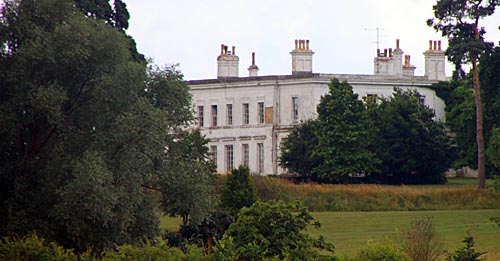 |
 |
|||
|
|
Foliejon Park is the major surviving manor house in Winkfield parish. It originally in the valley, in the old moat on the Drift Road, and was called Belestre. It was the Thames Valley home of John Drokensford, the early 14th century Bishop of Bath & Wells. There is a holy well in the grounds dedicated to St. Hubert, patron saint of deer hunting, which is said to cure eye complaints. The Bishop probably used it on his hunting expeditions into Windsor Forest. King Edward II gave the estate to his court favourite, Oliver de Bordeaux, in 1317, in return for an annual rent of a single red rose. He was the Constable of Windsor Castle and needed a country seat nearby. It may have been around this time that the place gained its new name of Foliejon. No-one knows exactly where this came from, but their is an old legend that the lady of the manor came home one day to find her footman in flagrante delicto with one of the village girls; at which she exclaimed, "This is Folly, John!" It is more likely that an early folly was built in the area by Bishop John, perhaps on the hill where the present house stands. From Oliver, Foliejon passed to his step-son, Sir William Trussell. However, in 1359, Trussell found himself obliged to swap the estate with King Edward III for Eaton Hastings, as the monarch wished to extend Windsor Great Park out this way. Trussell obviously liked East Berkshire. He never moved to Eaton, but purchased Shottesbrooke Park as his main residence instead. The house remained a Royal hunting lodge, given over to numerous forest rangers for nearly three hundred years. However, in 1630, it was granted Henry Henne, who was made a baronet twelve years later. Two generations later, in 1735, Penelope & Alice Henne, sold the place, briefly to a Mr. Bennett, who quickly passed it on to Lord Henry Beauclerk, the 4th son of Charles, the 1st Duke of St. Albans from Burford House in Windsor. Beauclerk was MP for Plymouth and Thetford and heavily reliant on the patronage of his kinsman, the Duke of Grafton. He and his wife, the daughter of the 4th Lord Lovelace from Ladye Place in Hurley, frequently wrote to the Duke for handouts to support their growing family. After Beauclerk's death, the property was sold, in 1771, to George Phillips Towry, a former naval lieutenant, who had recently won £20,000 in a lottery. He became Deputy Chairman of the Naval Victualling Board and something of a troubleshooter who got them out of sticky situations. He sold Foliejon after the death of his wife in 1800, but they both have memorial plaques in the parish church, as does their daughter, Anne, who married the Attorney General and Lord Chief Justice, the 1st Baron Ellenborough. It was the new owner, Thomas Bingley, who built a fine new house on the top of the hill; but perhaps it was just a property investment, for he sold it on to William Blane four years later. Blane, from an old Scottish family, had made his money in the East India Company. He was the brother of Dr. Sir Gilbert Blane, the man who prevented the spread of scurvy in the Navy and who lived nearby at Culverlands in Burghfield. Sadly, his daughter, Louisa, was drowned in the lake at Foliejon. Another family member, Robert Blane, lived at the Oaks in Ascot. The Blanes lived at Foliejon for four generations and were great benefactors to Winkfield. David Blane built Popels Almshouses in 1862. They moved back to Scotland in 1915 and let the house to the great socialite, the widowed Princess Hatzfeldt. She was born Clara Elizabeth Prentice, but was adopted by her aunt's husband, the Californian railway magnate, Collis Potter Huntingdon, and had married her German prince in 1889. Prince Franz had been well-known in the racing world and his horse, Ascetic Silver, won the Grand National in 1906. The princess brought the animal to Foliejon after her husband's death and there it was buried. In 1934, the Blanes sold the estate to a property company for £23,000. It passed to Claude Moss Leigh, a Jewish property manager and another racing fanatic, and, during the early part of War, was let to Simon Marks, the 1st Lord Marks of Broughton. From March 1942, it became the home of the exiled King Haakon VII of Norway and his family and was referred to as "the capital of Norway in exile". Another race-horse owner, the London glass and china retailer, TH Lawley owned the house in the 50s.
Details of the house's late 20th century history taken from 'The Winkfield Chronicles' by the Winkfield History Project Group (2000). Foliejon Park is a private residence. It can just about be seen up on the hill above the Drift Road.
|
|||
| © Nash Ford Publishing 2013. All Rights Reserved. | ||||



 Foliejon
Park
Foliejon
Park